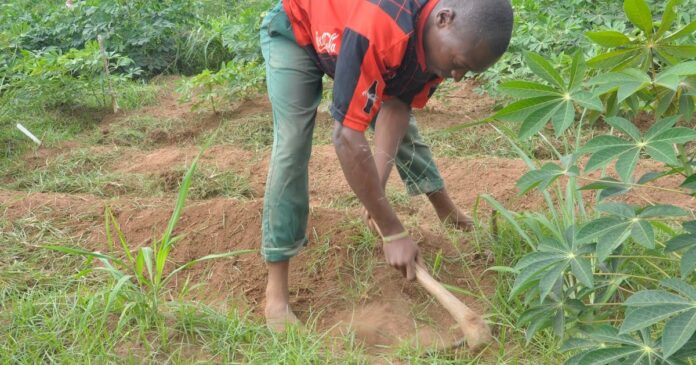How can you effectively control weeds in cassava farms?
Weed control by slashing, hand or hoe weeding can be labour intensive. The best way to control weeds in cassava farms is to adopt different cultural practices, especially at the land clearing, land preparation, seedbed preparation, planting and post-planting stages of growing cassava. You can use herbicides. But, you should read and understand the labels for guidelines on the application methods and rates. This will help avoid environmental problems that come with their use.
Read also: Safety Precautions in Agrochemicals Handling and Usage
Use IPM (Integrated Pests Management) practices at planting
Prepare your land properly: When clearing the land for planting cassava in wet areas, you can slash the bush before the rains start. Weeds will emerge on the cleared land soon after the rains. This usually happens when the weeds you have cleared do not cover the soil’s surface. You can then remove these weeds as you plant cassava stem cuttings. This will greatly reduce the frequency and labour of weeding in the cassava.
When preparing seedbeds for planting cassava, remove weed rhizomes, stolons and tubers. Also, remove other structures that germinate and spread the weed on the farm. Farm tillage tools should be checked and cleaned occasionally to ensure they are free of these weed structures. Otherwise, you will spread the weeds through contaminated tools.
Read also: How to Carry Out Land Preparation Under No-till Agriculture
Grow suitable cassava varieties: Some cassava varieties have heavy and early-branching characteristics. This habit allows these varieties to suppress weeds. Because they develop a lot of branches and leaves to form a thick canopy. The canopy shades weeds and prevents them from growing well. Cassava varieties with a late, high and less branching habit are not very good at suppressing weeds.
Mulch cassava seedbeds with dead plant foliage: Mulching is the covering of the soil surface with large amounts of plant foliage. Good sources of mulch materials are foliage from alley crops, leguminous plants and rice husks. Also, coffee hull and general crops and weeds residues. Straws of maize and guinea grass take too long to decompose. Avoid using weed residues containing weed seeds, rhizomes, stolons or tubers as mulch. This is because they can grow again when you take them to your farm.
Read also: What is Mulch, Mulch Types, Importance and Best Materials for Mulching?
Use cover crops as live mulch on seedbeds: You can grow cover crops as intercrops with cassava to reduce weed incidence. Plant cover crops close together to increase density and spread. This can suppress weed growth.
Plant cassava in association with other crops. Intercropping cassava with other crops like maize, rice, grain legumes and vegetables can also help control weeds in cassava farms.
Use IPM Practices after planting
Control weeds at the right time to prevent competition from weeds with cassava root formation. Weeds can also prevent bulking and reduce other damages the weeds may cause to the cassava.
If the cassava is the sole crop, weed three times before harvest at 3-4 weeks after planting, 7- 8 weeks after planting and 12 weeks after planting. After this, remove weed that grows again to make it easy to work between plants. Little or no weeds discourage rodents.
You may not have to control weeds in cassava farms that many times when you;
- remove rhizomes, stolons and tubers from the cassava seedbed.
- plant cassava varieties capable of suppressing weeds.
- use suitable intercrops.
- mulch well where necessary.
Improved fallow periods
During the fallow period grow cover crops like Mucuna pruriens var utilis on the land. Do this before growing cassava the following season. Growing mucuna will completely cover the land and prevent the growth of weeds. And so, no labour cost for weeding. During planting time you can plant the cassava directly into the mulch with little or no weeds to clear.
The mucuna is effective against spear grass and many other stubborn weeds. It produces lots of leaves and stays green up to 9 months after planting. It is, therefore, good for long term weed control and soil improvement.
Read also: What is Soil Tillage, Types of Soil Tillage and the Effects on Soil and Crops?
Canavalia ensiformis is another leguminous fallow plant. This is effective against spear grass and other stubborn weeds. However, the leaves drop earlier. Usually, 4-5 months after planting. After this period, if weeds receive enough sunlight they will grow abundantly. So, in areas with two wet seasons, it is advisable to grow Canavalia ensiformis, twice a year, early in the first and second wet seasons.
IN SUMMARY
Weeds control in cassava farms can be very problematic, but you should be able to sustainably and effectively control weeds in cassava farms. Just follow the directions given. If you have any questions, you may ask in a comment.
Reference:
Weed control in cassava farms – Alex Melifonwu et al, 2000.


